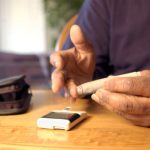
A person in a diabetic coma is still alive, but they do not respond to light, sound, touch or any stimulation. If left untreated a diabetic coma can be fatal. A diabetic coma can be confused with an insulin shock, but although the two may appear similar, they do contain their own unique differences.
Diabetic coma vs. insulin shock
Insulin shock is the body’s reaction to a drop in blood sugar – or hypoglycemia – as a result of too much insulin. Even though the condition is called insulin shock, there is no shock involved and insulin isn’t the main culprit. Even people without diabetes can experience insulin shock if their blood sugar drops low enough. The condition is called a shock because it makes the body react similarly to when blood pressure drops – a fight or flight response.
Symptoms of insulin shock are fast breathing, rapid pulse, dizziness, headache, numbness and hunger.
Diabetic coma, on the other hand, causes unconsciousness that can occur over the course of days or even weeks and also cause dehydration. Although both conditions must be treated immediately, diabetic coma can be fatal.
Causes of diabetic coma

Diabetic ketoacidosis: This is a condition where muscles become starved for energy, so the body begins breaking down fat from storage. This forms a toxin known as ketones and, if untreated, can contribute to diabetic coma.
Diabetic hyperosmolar syndrome: Diabetic hyperosmolar syndrome is when blood sugar levels top 600 mg/dL. When blood sugar reaches that point the blood becomes thick and syrupy. The excess sugar gets passes through the urine by being pulled from the blood, which causes fluid to be drawn from the body. If untreated, this condition can lead to dehydration as well as diabetic coma.
Diabetic coma symptoms
Diabetic comas result from both hypoglycemia and hyperglycemia, so symptoms may vary depending on the underlying cause.
Symptoms of a diabetic coma resulting from hypoglycemia are:
- Shakiness or nervousness
- Anxiety
- Fatigue
- Weakness
- Sweating
- Hunger
- Nausea
- Lightheadedness
- Trouble speaking
- Confusion
Symptoms of a diabetic coma from hyperglycemia are:
- Increase in thirst
- Frequent urination
- Fatigue
- Nausea and vomiting
- Shortness of breath
- Stomach pain
- Fruit breath odor
- Dry mouth
- Rapid heartbeat
Preventing diabetic coma
Prevention of diabetic coma is possible by following these helpful tips.
- Follow your meal plan.
- Monitor your blood sugar levels.
- Take medication as directed.
- Make plans with your doctor about how to handle elevated blood sugar when ill.
- Have fast-acting sources of glucose available for when blood sugar drops.
- Check for ketones when blood sugar is high.
- Minimize alcohol consumption and drink with caution.
- Tell friends and family members about how to spot a diabetic coma, so they can be prepared as well.
- Wear a medical ID bracelet.
Preventing insulin shock
- Being aware of the early signs.
- Test glucose levels regularly.
- Maintain a regular eating schedule.
- Consume smaller meals throughout the day.
- Have candies or glucose tablets on hand in case blood sugar drops.
- Carry a medical information card on you at all times.
- Inform friends and family so they, too, can spot the signs.
- Meet with your doctor regularly to spot changes in health.